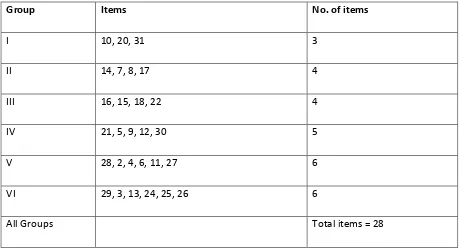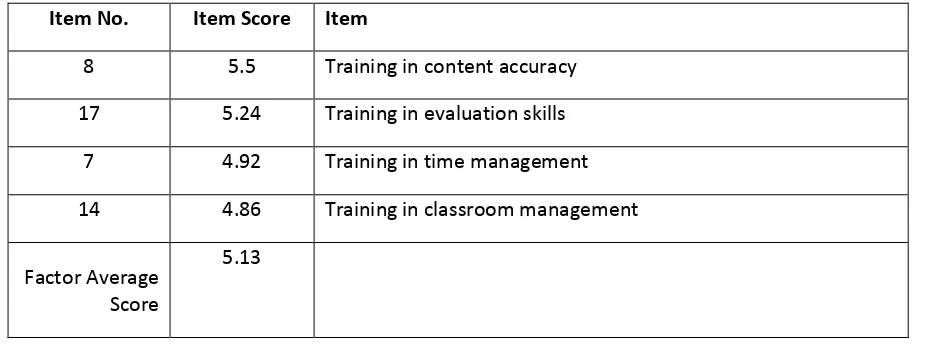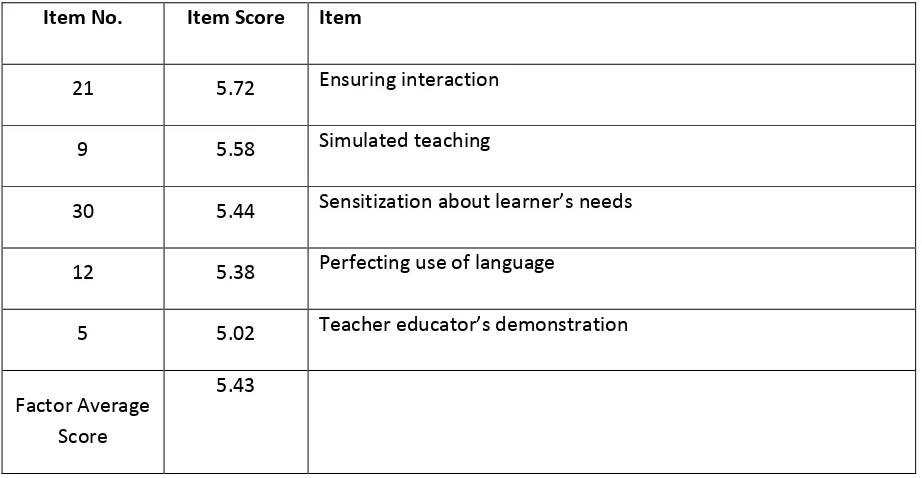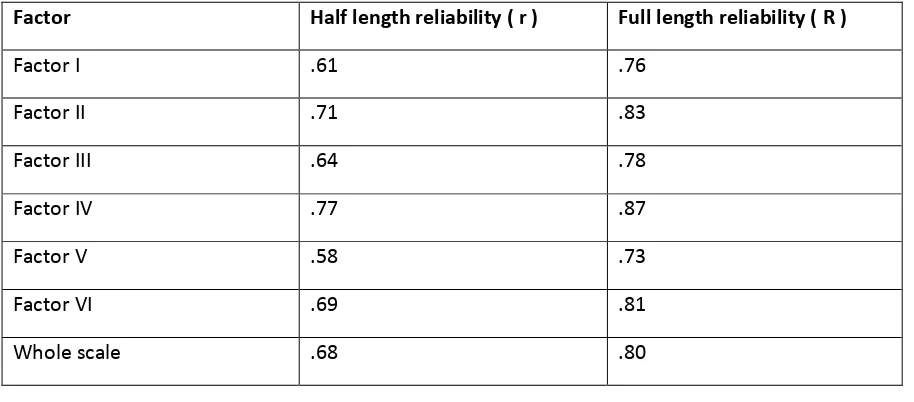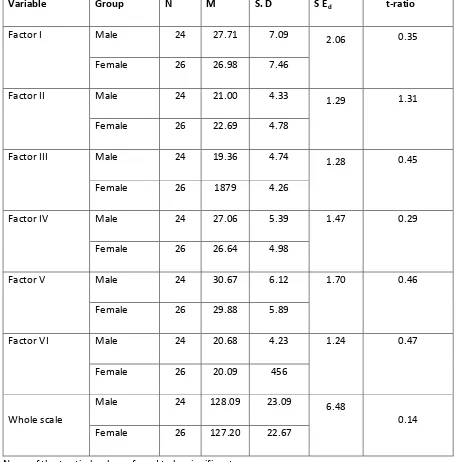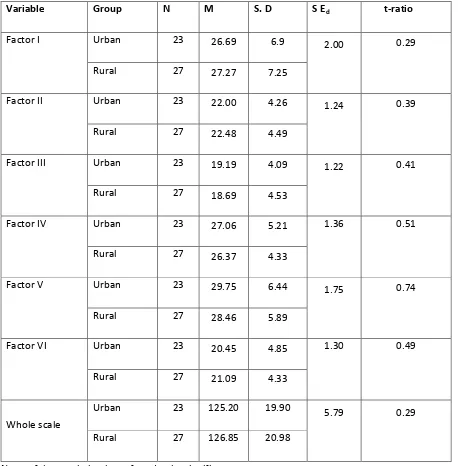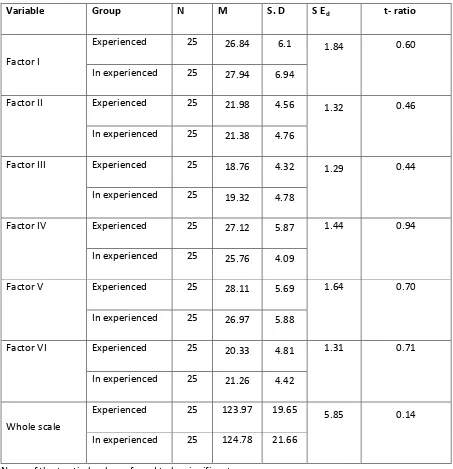Identification of Best Practices in Transfer of Training in Teacher Education as Perceived by Teacher Trainees
Dr. Vijay Kumar Grover Associate Professor
DAV College of Education, Abohar, Punjab
Abstract
This paper is devoted to investigate best practices for transfer of training as perceived by teacher
trainees. It is thought that it would be best to study the subject from point of view of customer of the
service. An opinionnaire was developed and standardised which could be scored for preference on
different training practices as perceived by the participants. Data was analysed by utilising cluster
analysis to make group of items which were dubbed (named) after studying nature of items. These
groups of items formed factors running under the concept under investigation. Items in these groups are
ranked ordered to understand nature and preference of trainees for practices. Also factors are ranked
ordered on the basis of average score for the items as well as factors. On the basis of these rankings and
t-test across attribute variables research questions were answered. It has been found that best practices
for teacher training as perceived by the trainees could be classified in terms of six (Training in technical
skills, Training in content accuracy and management skills, Teacher led monitoring, Training in relation
management, Training in preparation and use of teaching aids and Training in presentation skills), four
(Student concern, Content concern, Tool concern, Technique concern) and finally two (Task & Relation)
factors. Also it is found that preference for practices in teacher training do not differ significantly across
attribute variables- Gender, Locality and Experience. Study revealed that teacher trainees endorse
practices in vogue as well as want to include emerging practices involving technology and techniques.
Identification of Best Practices in Transfer of Training in Teacher Education as Perceived by Teacher Trainees
Teaching has journeyed through number of phases from a charity to highly professional activity. When we term any occupation a profession it involves essentially exhibit of repertoire of skills, attitudes and characteristics which are needed to be learnt and applied on job performance. More importantly it becomes a business like activity for which somebody has to pay, thus involves accountability as its integral element. For a professional activity we need to devise a training program which must train the candidates in necessary skills and attitudes. But it is a common observation that good amount of training go waste due to non practicing of the learnt skills. Thus a huge of investment is lost between training and actual performance on job. Rackham and Ruff (1991) in their study of sales training at Xerox, reported there was an 87% of loss of skills within one month of the completion of the training. Baldwin and Ford (1988) note some estimates that suggest only 10% of training outcomes are transferred back to the job. This is embracing for any country and stakeholders involved in the venture. The issue of carry-over from training to the performance situation is referred to as the problem of the “transfer of training.” Baldwin and Ford (1988) define the positive transfer of training "as the degree to which trainees effectively apply the knowledge, skills and attitudes gained in a training context to the job". Training is actually mastering on a collection of “know how” tools which could be used in similar or different situations, immediately or later in the career to accomplish the task. Given the huge investments involved, it becomes urgent to understand the dynamics of transfer of training. This effective transfer of training is aimed to minimize transfer losses while improving the yield from any training program.
training. The proposed study draws on a constructivist perspective (Creswell, 2003) in order to guide our interpretation of the qualitative data. Our goal is to capture and describe how teacher trainees perceive transfer of training can be made effective which may endorse the present trend or highlight some new practices. Studies exploring transfer of training have commonly focused only on theoretical aspects and based on experts’ opinions like educationists or even policy makers. We are trying here to study the subject from the point of view of the customerswho are most important stakeholders in the venture. Ultimately the purpose is to propose a refined model of transfer of training that fuses prevalent and emerging practices for a synthetic model fit for present times. These thoughts in mind led to the selection of proposed study.
Objectives
The proposed investigation has been conducted to attain the following objectives.
To construct and standardise opinion measure to assess the best practices in teacher training using perceptions of teacher trainees.
To find out the best practices as perceived by teacher trainees. To study the variations within group across some attribute variables.
To synthesise the findings in terms of an emphasis model for training of teachers.
Research Questions
What are different ‘best practices’ for transfer of training in teaching as perceived by teacher trainees?
Do theses best practices vary with respect to some attribute variables?
Research Design & Methodology
Sample of the Study
Fifty teacher trainees participated in the study. The sample was a snowball type in which indirect purposiveness is used to preserve the randomness character of the. In snowball sampling we select a convenient sample of two subjects and then they name two persons each who might be interested to be the participants in the study. In this way a progressive chaining mechanism is used which automatically makes the sample a random one.
Developing an Opinionnaire
Development of opinionnaire involve following steps Theoretical constructs for the concept Framing of items
Selection of items Organization of items Try out of the measure
Inter-item Correlation (Item Analysis)
Inter-item matrix (33X33) was developed from raw data. Significant correlations were retained for the purpose of development of group of items. This analysis resulted in formation of six groups which has significant correlations among the group members.
Table 1: Detail of groups of items
Group Items No. of items
I 10, 20, 31 3
II 14, 7, 8, 17 4
III 16, 15, 18, 22 4
IV 21, 5, 9, 12, 30 5
V 28, 2, 4, 6, 11, 27 6
VI 29, 3, 13, 24, 25, 26 6
Group of items so formed revealed the following findings.
Twenty eight items could be included in at least one or other group of items, meaning there by five items (item No. 1, 19, 23, 32 & 33) could not be include in any of the group, which need to be deleted from the measure.
Groups of items are nothing but factors (constructs) of the concept under investigation.
Score in respect of items in a group are summed up and averaged, the placed in rank order to understand relative ranking of items by the group.
Groups so obtained are dubbed for name according to the nature of items it contains. Tables 2 to 7 describe groups of items (factors) of the measure.
Table 2: Factor I: Training in technical skills Item No. Item Score Item
10 5.16
Training in use of technological aids
20 4.82 Ensuring relation building
31 4.44 Recording teaching electronically
Factor Average Score
4.81
Table 3: Factor II: Training in content accuracy and management skills Item No. Item Score Item
8 5.5 Training in content accuracy
17 5.24 Training in evaluation skills
7 4.92 Training in time management
14 4.86 Training in classroom management
Factor Average Score
Table 4: Factor III: Teacher led monitoring Item No. Item Score Item
18 4.76 Continuous evaluation
16 4.76 Continuous monitoring
15 5.04 Training in teaching methods
22 5.24 Training in teaching behaviours
Factor Average Score
4.95
Table 5: Factor IV: Training in relation management Item No. Item Score Item
21 5.72 Ensuring interaction
9 5.58 Simulated teaching
30 5.44 Sensitization about learner’s needs
12 5.38 Perfecting use of language
5 5.02 Teacher educator’s demonstration
Factor Average Score
Table 6: Factor V: Training in preparation and use of teaching aids Item No. Item Score Item
2 5.32 Reliable observation by the teacher 28 4.92 Training in use of teaching aids
6 4.78 Training in preparing teaching aids
4 4.44 Perfecting lesson planning
11 4.42 Perfecting in teaching temperament
27 4.1 Perfecting in record maintenance
Factor Average Score
4.66
Table 7: Factor VI: Training in presentation skills Item No. Item Score Item
13 5.48 Ensuring best use of voice
24 5.28 Training in classroom management
26 5.14 Training in psychological orientation
25 5.00 Perfecting in lecturing
29 4.94 Perfecting in teaching temperament
3 4.76 Peer feedback
Factor Average Score
5.10
Table 8: Factors obtained for teacher trainees in rank order
Sr. No. Factor Item
1 IV Training in relation management
2 II Training in content accuracy and management skills 3 VI Training in presentation skills
4 III Teacher led monitoring 5 I Training in technical skills
6 V Training in preparation and use of teaching aids Standardisation of Opinion Measure
Validity of the Scale
As in the previous section we could find that six factors could be discovered conveniently. This can be taken as construct validity of the measure. As a crude test for validity a group of ten subjects were interviewed and asked the response for particular items and found that good amount of agreement(83%) existed between what they responded and what they expressed orally.
Internal Consistency of the Measure
Reliability of the measure was calculated by using part whole correlation method to ensure the internal consistency of the scale. The values for part whole correlations range from 0.63 to 0.26. Thus it is concluded that developed measure has sufficient internal consistency.
Also test-retest reliability was computed for constituent measures as well as for whole of the scale. Table 9: Reliability values of the sub measures and the whole measure
Factor Half length reliability ( r ) Full length reliability ( R )
Factor I .61 .76
Factor II .71 .83
Factor III .64 .78
Factor IV .77 .87
Factor V .58 .73
Factor VI .69 .81
Assessment of Normality of the Sample
Normality of the sample has been assessed by using K-S test and value for | Cpo-Cpe |max= 0.0356has been found to be much lesser than expected value (0.1923, 0.2305 at 0.05 & 0.01 level), which implied sample was normal and we could apply parametric tests for data analysis.
Table 10: Summary of comparing means for Gender variation for teacher trainees in respect of constituent factors and whole measure
Variable Group N M S. D S Ed t-ratio
Factor I Male 24 27.71 7.09 2.06 0.35
Female 26 26.98 7.46
Factor II Male 24 21.00 4.33 1.29 1.31
Female 26 22.69 4.78
Factor III Male 24 19.36 4.74 1.28 0.45
Female 26 1879 4.26
Factor IV Male 24 27.06 5.39 1.47 0.29
Female 26 26.64 4.98
Factor V Male 24 30.67 6.12 1.70 0.46
Female 26 29.88 5.89
Factor VI Male 24 20.68 4.23 1.24 0.47
Female 26 20.09 456
Whole scale
Male 24 128.09 23.09 6.48
0.14
Female 26 127.20 22.67
Table 11: Summary of comparing means for Locality variation for teacher trainees in respect of constituent factors and whole measure
Variable Group N M S. D S Ed t-ratio
Factor I Urban 23 26.69 6.9 2.00 0.29
Rural 27 27.27 7.25
Factor II Urban 23 22.00 4.26 1.24 0.39
Rural 27 22.48 4.49
Factor III Urban 23 19.19 4.09 1.22 0.41
Rural 27 18.69 4.53
Factor IV Urban 23 27.06 5.21 1.36 0.51
Rural 27 26.37 4.33
Factor V Urban 23 29.75 6.44 1.75 0.74
Rural 27 28.46 5.89
Factor VI Urban 23 20.45 4.85 1.30 0.49
Rural 27 21.09 4.33
Whole scale
Urban 23 125.20 19.90 5.79 0.29
Rural 27 126.85 20.98
Table 12: Summary of comparing means for Experience variation for teacher traineesin respect of constituent factors and whole measure
Variable Group N M S. D S Ed t- ratio
Factor I
Experienced 25 26.84 6.1 1.84 0.60
In experienced 25 27.94 6.94
Factor II Experienced 25 21.98 4.56 1.32 0.46
In experienced 25 21.38 4.76
Factor III Experienced 25 18.76 4.32 1.29 0.44
In experienced 25 19.32 4.78
Factor IV Experienced 25 27.12 5.87 1.44 0.94
In experienced 25 25.76 4.09
Factor V Experienced 25 28.11 5.69 1.64 0.70
In experienced 25 26.97 5.88
Factor VI Experienced 25 20.33 4.81 1.31 0.71
In experienced 25 21.26 4.42
Whole scale
Experienced 25 123.97 19.65 5.85 0.14
In experienced 25 124.78 21.66
None of the t-ratio has been found to be significant. Answers to the Research Questions
Research Question 1: What are different ‘best practices’ for transfer of training in teaching as perceived by teacher trainees?
Training in teaching behaviours (6.50) Ensuring best use of voice (5.42)
Perfecting use of language (5.38)
Reliable observation by the teacher (5.22)
Training in content accuracy (4.98)
Perfecting in lecturing (4.92)
Training in psychological orientation (4.92)
Ensuring interaction (4.90)
Training in teaching methods (4.86)
Sensitization about learner’s needs (4.76)
These items could be combined to form following categories.
1. Ensuring interaction + Sensitization about learner’s needs + Training in psychological orientation = STUDENT CONCERN ( R )
2. Training in content accuracy = CONTENT CONCERN ( Ts ) 3. Perfecting use of language = TOOL CONCERN ( Tm )
4. Reliable observation by the teacher =TECHNIQUE CONCERN ( Tm )
In terms of factor wise ranking
Correlation analysis revealed six underlying factors for teacher trainees. Taking first two items from each of the factors we can get most approved ten practices by teacher trainees as a group. These twelve items are as follows.
Training in use of technological aids (5.16) Ensuring relation building (4.82)
Training in content accuracy (5.50) Training in evaluation skills (5.24) Continuous evaluation (4.76) Continuous monitoring (4.76) Ensuring interaction (5.72) Simulated teaching (5.58)
Reliable observation by the teacher (5.32) Training in use of teaching aids (4.92) Ensuring best use of voice (5.48)
Training in classroom management (5.28)
In terms of factors/dimensions (repertoire of practices)
If we consider practices to be included as cluster of practices to cover the whole domain of the subject we can study in terms of factors obtained for teacher trainees. The six practices/ dimensions are given below in order of preference.
Training in relation management ( R )
Training in content accuracy and management skills ( Ts ) Training in presentation skills( Tm )
Teacher led monitoring ( Tm ) Training in technical skills ( Tm )
Training in preparation and use of teaching aids ( Tm )
In conclusion we can answer the research question as follows.
Teacher trainees endorse training practices which involves- student concern ( R ), tool concern ( Tm ), technique concern ( Tm ), content concern ( Ts )
Training must involve accomplishing the task and building relation with learners. Any training activity which does not attend the task or relation should not be included in the training program.
Research Question 2: Do theses best practices vary with respect to some attribute variables? This question is answered by comparing the means across the groups.
The t-ratios show that none of the value has been found to be significant, for any of the factor as well as for whole measures across any of the attribute variation- Gender, Locality and Experience. This implies that gender, locality and experience have no influence on preference of teaching practices in any sense. This makes things easier for framing uniform teaching training program without any consideration of attribute variables.
Educational Implications of the Study
similar to the Kerlinger’s (1967) study of educational attitudes (second order factors) which classified people (teacher) as- Person oriented and Task oriented. As mentioned before the outcome of the study has dual implication. Study approves the already practices in vogue but could also bring out some new emerging practices (like technology oriented practices) inteacher training. Thus it has worked well to develop a synthetic model for transfer of training in teacher education.
Suggestions for further Research
Many directions are emerging from the present piece of research work, which can be listed as follows
This study could be extended in terms of conditions for utilizing best practices, personal and organizational characteristics for implementing best practices.
Best practices obtained could be put to test for approval of established literature and other stakeholders in the venture.
Best practices can be compared in respect of different levels of teaching and other variables like- age group, academic stream, personality orientation and the like.
Best practices for transfer of training can also be studied by utilising perceptions of teachereducators and working teachers.
Comparison of perceptions of teacher trainees, working teachers and teacher educators can be another interesting proposal for investigation.
Best practices for transfer of training can be compared in respect of different countries and philosophies behind the differences so obtained.
References:
Baldwin, T.T. and Ford, J.K. (1988). Transfer of training: a review and directions for futureResearch. Personnel Psychology, 41, 63-105.
Bjomberg, L. (2002). Training and development: Best practices. Public Personnel Management, 31(4), 31, 507–517.
Burns, T., & Stalker, G. M. (1961).The management of innovation. London: Tavistock.
Clardy, A. (1984). Managing the conditions of successful change: a trainer's job is never done.Baltimore, Maryland: Johns Hopkins University Occasional Paper in the AppliedBehavioral Science, #3.
Creswell, J. W. (2003). Research design. Thousand Oaks, CA: Sage.
Ford, J.K., Quinones, MA, Sego, DJ, and Sorra, JS. (1992). Factors affecting the opportunity to perform trained tasks on the job.Personnel Psychology, 45, 3, 511-527.
Ford, JK, and Weissbein, DA. (1997). Transfer of training: an updated review and analysis. Performance Improvement Quarterly, 10, 2, 22-41.
Goldstein, IL, and Ford, JK. (2002). Training in organizations. Belmont, CA: Wadsworth.
Hall, G.E., Loucks, S.R., Rutherford, W.L., and Newlove, B.W. (1975). Levels of use of the innovation: a framework for analyzing innovation adoption. Journal of TeacherEducation, 26, 1, 52-56.
Hunter, Madeline. (1971). Teach for Transfer, A Programmed Book. El Segundo, CA: TIP Publication.
Huselid, M. (1995). The impact of human resource management practices on turnover, productivity, and corporate financial performance. International Journal of Human Resource Management, 8, 263–276.
Jelsma, O, Van Merrienboer, J.J.G. and Bijlstra, J.P. (1990). The ADAPT design model: towardsinstructional control of transfer. Instructional Science, 19, 89-120.
Kirkpatrick, D. (1974). Techniques for evaluating training programs.Journal of the American Society of Training Directors, 13, 3–9, 21–26.
Kirkpatrick, D.C. (1994). Evaluating Training Programs: The Four Levels. San Francisco: Berrett-Kohler.
Laker, D. R.(1990). Dual dimensionality of training transfer.Human Resources Development Quarterly, 1, 3, 209-235.
MacDuffie, J. P. (1995). Human resource bundles and manufacturing performance: Organizational logic and flexible production systems in the world auto industry. Industrial and Labor Relations Review, 48(2), 197–221.
Major, D. A., Davis, D. D., Germano, L. M., Fletcher, T. D., Sanchez-Hucles, J., & Mann, J.
(2007). Managing human resources in information technology: Best practices of high-performing
Purcell, J. (1999). Best practice and best fit: Chimera or cul-de-sac? Human Resource Management, 9, 26–41.
Rackham, N. and Ruff, R. (1991).Managing Major Sales. New York: HarperBusiness.
Rivera, R. J., & Paradise, A. (2006).State of the industry in leading enterprise. Alexandria, VA: ASTD Press.
Rylatt, A. (2001). Learning unlimited: Transforming learning in the workplace (2nd ed.). London: Kogan Page.
Salinger, R. (1979). Measuring behavioral change with results from training. In R.O.Peterson(ed.).Determining the Payoff of Management Training (pp. 113-150). Madison, WI:ASTD Press.
Salas, E. and Cannon-Bowers, J.A. (2001). The science of training: a decade of progress. Annual Review of Psychology, 52, 471-499.
Salinger, R. (1973). Disincentives to Effective Employee Training and Development. Washington, DC: US Civil Service Commission.
Thorndike, E.L. and Woodworth, RS. (1901). The influence of movement in one mental functionupon the efficiency of other functions. Psychological Review, 8, 247-261.
Wood, S., & Albanese, M. (1995). Can we speak of a high commitment management on the shop floor? Journal of Management Studies, 32, 215–247.
